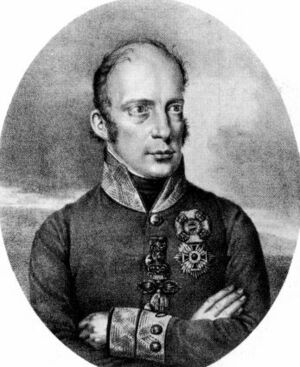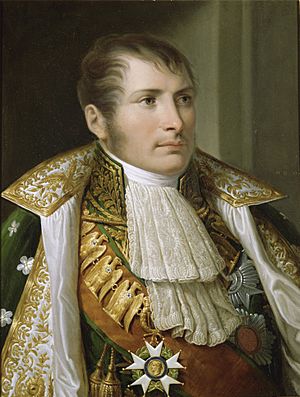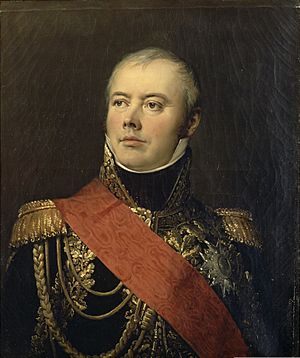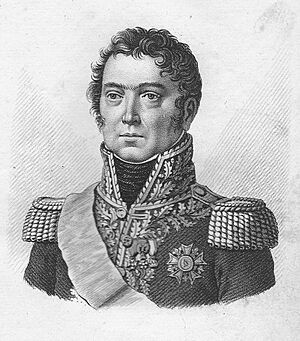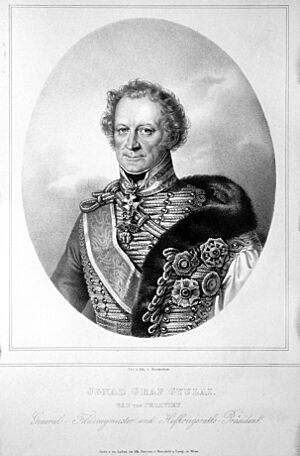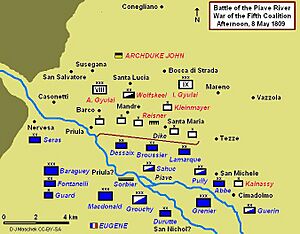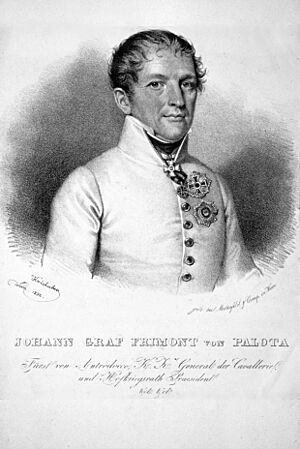Battle of Piave River (1809) facts for kids
Quick facts for kids Battle of Piave River (1809) |
|||||||
|---|---|---|---|---|---|---|---|
| Part of the War of the Fifth Coalition | |||||||
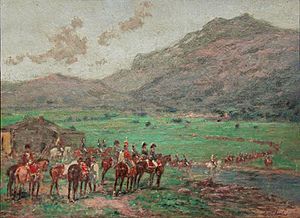 The French army crossing the Piave in 1809. |
|||||||
|
|||||||
| Belligerents | |||||||
| Commanders and leaders | |||||||
| Strength | |||||||
| 44,800-45,000 | 24,120-28,000 | ||||||
| Casualties and losses | |||||||
| 2,000-3,000 | 3,600-3,896 15 guns |
||||||
The Battle of Piave River was a big fight that happened on May 8, 1809. It was part of the Napoleonic Wars, a time when France fought many European countries. This battle took place near Nervesa della Battaglia, in modern-day Italy.
On one side was the Franco-Italian army, led by Eugène de Beauharnais. On the other side was the Austrian army, led by Archduke John of Austria. The Austrians tried to defend their position behind the Piave River. But Eugène's army was larger and stronger, and they won the battle.
Before this battle, the Austrians had invaded Venetia and pushed the French and Italian forces back. But then, news arrived that the Austrians were losing battles in Bavaria. So, Archduke John decided to retreat. When he heard that Eugène's army was crossing the Piave River, he turned back to fight. He hoped to slow down the French pursuit.
Eugène sent his first troops across the river early in the morning. They met strong Austrian resistance. But French cavalry arrived and helped stabilize the situation. The river started to rise quickly, making it hard for more French soldiers to cross. In the late afternoon, Eugène launched his main attack. This attack broke through the Austrian defenses and forced them to retreat. The Austrian army was damaged but not completely destroyed. They continued their withdrawal into Carinthia (now in Austria) and Carniola (now in Slovenia).
Contents
Background to the Battle
At the start of the 1809 war between the Austrian Empire and the First French Empire, Archduke John led his army into northeastern Italy. Emperor Napoleon I put his stepson, Eugène, in charge of the Army of Italy. On April 16, John defeated Eugène at the Battle of Sacile.
Another Austrian force also moved south from the Tyrol. Because of these threats, Eugène's army pulled back about 130 kilometers (80 miles) to the Adige River.
Once near Verona, Eugène's army received more soldiers. He also reorganized his forces. Archduke John had sent some of his troops to block Venice. This meant John arrived at the Adige River with fewer soldiers than Eugène. When Napoleon won the Battle of Eckmühl, the Austrian Emperor ordered John to retreat and defend Austria. Eugène then formed a special "Light Brigade" to chase the retreating Austrians.
From April 27 to 30, John fought Eugène at the Battle of Caldiero. John successfully stopped Eugène's attempts to outflank him. The Austrians lost about 700 killed or wounded and 872 captured. The French lost about 1,400 soldiers.
On May 1, Archduke John ordered his army to retreat east. The Austrian rear guard (the troops protecting the main army from behind) fought off the French on May 2. The Austrians then paused at the Brenta River until May 5, before continuing their retreat to the Piave River. Eugène followed them closely. He also sent a division to help relieve the blockade of Venice. Eugène made his Light Brigade stronger, turning it into a Light Division, to help with the chase.
On May 7, the Austrian army camped near Conegliano, about 8 kilometers (5 miles) northeast of the Piave River. They burned all the bridges. Eugène's cavalry reached the river and found places to cross. When John heard the French were nearby, he marched his troops back to defend the river.
Planning the Attack
Eugène thought most of Archduke John's army was still far away at Conegliano. So, he planned a bold attack to cross the Piave River. He didn't know that the Austrian army was actually very close, only 4 kilometers (2.5 miles) north of the river. John had between 24,120 and 28,000 soldiers at the Piave, while Eugène had many more.
To avoid another defeat like Sacile, Eugène made sure most of his army was ready. He planned to make a fake attack at one crossing point (Nervesa). Meanwhile, his Light Division would lead the main attack at another crossing point (Priula). He also ordered his cavalry to cross at a third point (San Nichiol) and then move to help the main attack. To support the Light Division, Eugène gathered many cannons on the south bank of the river. If the Light Division could create a safe spot on the other side, Eugène planned to send more troops across.
River Crossings and Early Fights
At 7:00 AM, the Light Division, with nearly 5,000 soldiers, crossed the river. Archduke John's army was already moving into position behind a stream called the Piavisella. John had placed his troops in a line across the area. By 8:00 AM, the Light Division was about 400 meters (1,300 feet) from a defensive wall (dike).
John sent almost all his cavalry to attack the Light Division. The French soldiers quickly formed into large squares to defend themselves. They fought off many waves of Austrian horsemen. As the Austrian cavalry pulled back, 24 Austrian cannons opened fire on the French.
These cannons were about 800 yards from the French. The cannon fire caused many injuries to the French squares. French messengers rushed to get help. Eugène quickly ordered 20 French cannons to cross the river. When they arrived, the French formed their own 24-gun battery and fired back at the Austrians. The Austrian cavalry leader, Wolfskeel, asked for infantry support, but none arrived.
While this was happening, French cavalry divisions crossed the Piave at San Nichiol. They met an Austrian brigade and pushed them back. Around 9:00 AM, more French cavalry crossed, allowing the others to move left to help the Light Division. The French cannon fire then slowed down because they had left their extra ammunition behind.
Around 10:00 AM, the Austrian cavalry attacked again. They rode towards the French in three lines. But the French cavalry was ready. They charged back, and a huge fight broke out between the horsemen of both armies.
During this intense cavalry battle, a French soldier killed Wolfskeel, the Austrian cavalry commander. His second-in-command was captured. Without their leaders and outnumbered, the Austrian horsemen broke and ran. The Austrians managed to save ten cannons, but the French captured 14 of them. The Austrian artillery chief, Reisner, was also wounded and captured.
The French cavalry chased the fleeing Austrians. They met Austrian infantry brigades that were formed into squares. The French horsemen tried to break these squares but couldn't. So, they fell back to the dike, where they joined the Light Division.
Rising Waters and Final Attack
The Piave River began to rise quickly, but Eugène kept sending more troops across. Around noon, a large part of two French divisions crossed the river. While these troops started to test the Austrian defenses, more French soldiers crossed at San Nichiol.
The fighting slowed down after 1:00 PM as Eugène tried to get more troops across the river before the water became too high. By 3:00 PM, he had to stop all crossings because the water was too dangerous. This meant only about half of his infantry and all his cavalry had made it to the north bank. If the battle went badly, these troops would be trapped with a flooded river behind them. But Archduke John's cavalry was in disarray, so he didn't order his foot soldiers to attack.
By this time, Eugène had about 27,000 to 30,000 French and Italian soldiers on the north bank. He planned a big attack on the Austrian line. On the right side, he ordered General Grenier to push the Austrian left wing. The French attack began in the late afternoon. The Austrians tried to counterattack with their last cavalry, but the French quickly pushed them back. The Austrians then retreated.
The main French attack was led by General MacDonald. It started with a bombardment from 24 cannons. MacDonald's attack broke through the Austrian lines. Archduke John had to use his last reserve troops, but even these elite soldiers couldn't stop the French. The French pushed forward, taking key positions. The Austrian army finally broke and fled north towards Conegliano. As night fell, Eugène stopped the chase.
Aftermath of the Battle
Archduke John retreated to Conegliano that night and then moved his troops towards Sacile. He managed the retreat well. Eugène stopped his advance to let his army regroup. The French reported about 700 casualties, but a more likely number is around 2,000. The Austrians lost 3,896 soldiers, including 398 killed, 697 wounded, 1,681 captured, and 1,120 missing. The French also captured 15 Austrian cannons. Wolfskeel, the Austrian cavalry commander, was among the dead.
At Sacile, Archduke John made a big mistake. He split his army into two parts. This made it easier for Eugène to advance from Italy into the Austrian Empire. One historian said that John's handling of the campaign from the Piave to Hungary was a "failure."
The next major battle was the Battle of Tarvis from May 15 to 18. In this fight, small Austrian garrisons bravely defended against much larger French and Italian forces. This was followed by another Austrian defeat at the Battle of Sankt Michael on May 25. Eugène continued to chase John into Hungary. He defeated John again at the Battle of Raab on June 14. Then, Eugène joined Napoleon's main army for the huge Battle of Wagram on July 5 and 6. The last notable action in this area was the Battle of Graz from June 24 to 26.


